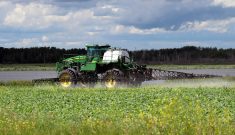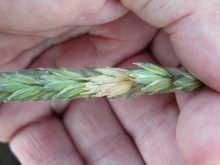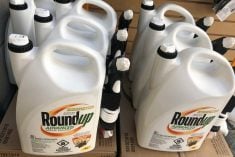Late spring frosts and extremely dry conditions in various parts of the Prairies mean a lot of farmers will face uneven maturity at harvest time — especially with canola crops that had to be reseeded in parts of Manitoba and Saskatchewan.
The question is, what can they use pre-harvest to dry down their crops and even out maturity for harvest? Clark Brenzil, provincial weed specialist with the Saskatchewan Ministry of Agriculture says although there are more desiccants on the market today for many different crops, including some forages, there are still limited options for canola.
Read Also

Claas brings 1000 Series SP forage harvesters to Canada
In mid-August, Claas unveiled its new line of Jaguar forage harvesters at an event in Visalia, California, deep in the heart of that state’s dairy region.
“If producers use a desiccant, such as Reglone, for canola, the dry down is so quick that it risks pods being disrupted,” says Brenzil, adding that for Polish canola it’s not as great an issue. “But if producers use a desiccant on Argentine canola they should only do it when the crop is lodged.”
Bruce Dalgarno farms near Newdale, Manitoba, and he generally still swaths his canola because of problems with pod shatter. He’s even tried a product designed to reduce pod shatter but says it didn’t make a lot of difference for him. “We tried the product on a couple of plots in different fields,” he says. “The first plot gave the same yield as the rest of the field we had swathed. The second plot, which was in a field about eight miles away, got a thunderstorm so we couldn’t harvest it for four or five days. During those days it was very windy, and the pods shattered. There was 22 bushels per acre drop in yield compared to the first field, including in the second plot. Plus, you still have to drive through the crop to spray it on so you’re losing your sprayer track ruts in the crop. There would have to be better technology or a different product before we would try that again.”
The purpose of desiccants is to dry down any lush plant material as quickly as possible so an evenly mature crop can be harvested efficiently, or in some cases to move the harvest window if non-favourable weather conditions are expected.
“Perhaps there’s going to be a stretch of good, dry days before rain settles in again for several days, so the idea is to manipulate your harvest date so it occurs in that window of opportunity,” says Brenzil. “The first available day you apply Reglone and in four days you’re out there with the combine.”
The use of desiccants has increased as more products have come to market over the past few years. “Desiccants have become more economical,” says Brenzil. “It used to be that diquat was the only player in that game, but now there are not only more diquat products available but others with different active ingredients, such as aflufenacil, found in Heat from BASF.”
Brenzil believes the real challenge for producers is that they are trying to compensate for agronomic changes that result in uneven maturity, and believes there are ways to reduce unevenness without resorting to pre-harvest treatments.
“One way to alleviate the problem of uneven maturity is to reduce the number of secondary tillers or branches produced by the plant by increasing seeding rates and closing in row spaces,” says Brenzil.
A wider row spacing, say 12 inches, allows the plants more opportunity to grow out sideways to fill in-between the rows, and it results in plants producing more tillers or branches to do that. The more tillers or branches that are produced, the more uneven maturity is going to be. If the row spacing is reduced to eight to 10 inches the seeding rate is increased by 50 per cent, so there is more competition, and more primary stems being produced rather than secondary tillers later on into the season. A single stem with maybe just one or two tillers also gives bigger, plumper kernels so the overall quality of the grain improves.
The last word on pre-harvest treatments is that there’s no magical solution to enhance crop maturity, says Brenzil. “If you terminate the plant prematurely, whether with glyphosate or a desiccant, you run into similar problems,” he says. “The advantage to a desiccant is that they tend to leave less residues since they are not systemic like glyphosate.”
















